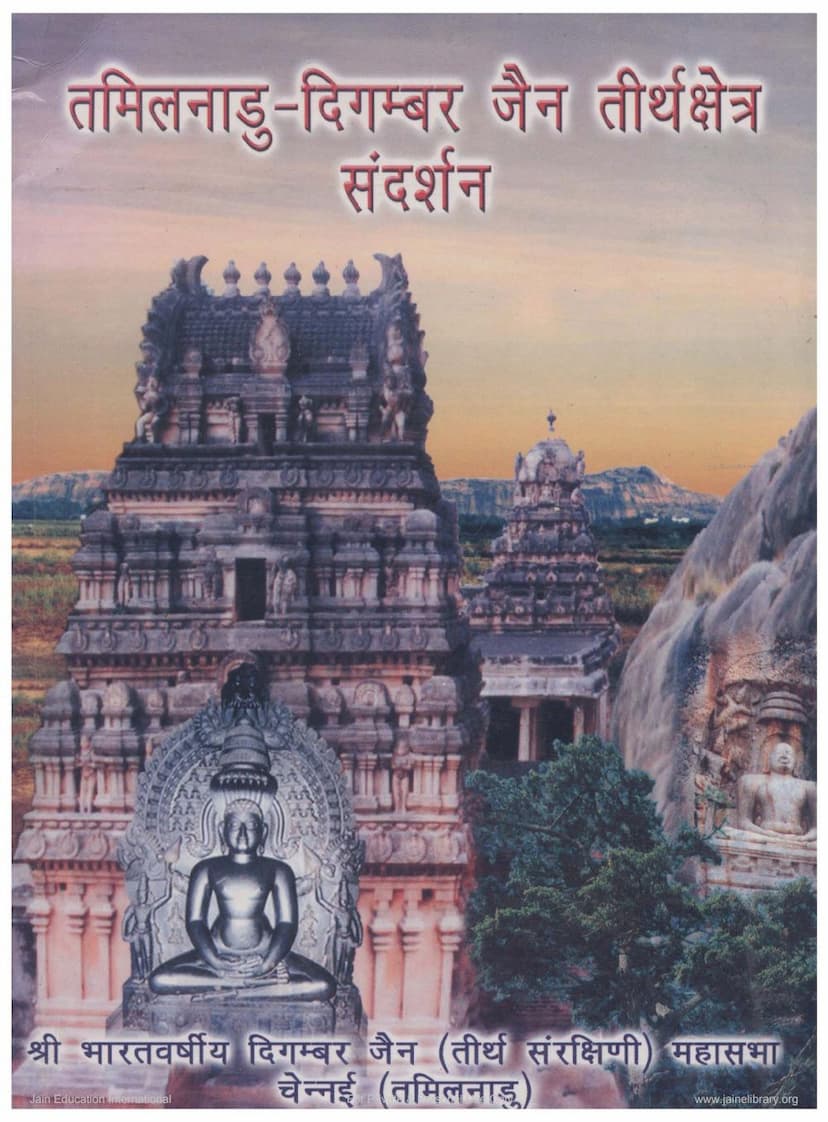Tamilnadu Digambar Tirthkshetra Sandarshan
Added to library: September 2, 2025

Summary
Here's a comprehensive summary of the provided Jain text, focusing on its key themes and content:
The book, "Tamilnadu Digambar Tirthkshetra Sandarshan" (A Guide to Digambar Jain Holy Places in Tamil Nadu), published by the Bharatvarshiya Digambar Jain Mahasabha, Chennai, serves as an illustrated souvenir of ancient Digambar Jain temples in Tamil Nadu. It was released on March 17, 2001, during the first convention of the Tirth Sanrakshini Mahasabha in Chennai, marking the beginning of the new century.
Core Purpose and Message:
The primary objective of this publication is to:
- Document and showcase the historical and religious significance of Jain sites in Tamil Nadu.
- Highlight the dilapidated state of many ancient Jain temples and the urgent need for their renovation and preservation.
- Inspire the Jain community and others to contribute financially and actively towards the restoration efforts.
- Educate readers about the rich Jain heritage in Tamil Nadu, its history, cultural impact, and the contributions of ancient Jain acharyas.
Key Themes and Content:
-
The Importance of Tirthas (Holy Places): The book repeatedly emphasizes that visiting and supporting Jain Tirthas is a highly meritorious act, bringing manifold blessings and wealth. It positions these holy places as the "lifeblood of the Tirth Dharma" and a source of identity.
-
The Role of the Bharatvarshiya Digambar Jain Tirth Sanrakshini Mahasabha: The Mahasabha, particularly its Chennai branch and its dedicated leadership (like Shri Nirmal Kumarji Sethi), is portrayed as the driving force behind the preservation and renovation movement. Their tireless efforts are credited with raising awareness, mobilizing resources, and undertaking significant restoration projects across various states, including Tamil Nadu.
-
Historical and Archaeological Significance: The text delves deep into the ancient history of Jainism in Tamil Nadu. It asserts that Jainism has a very long and rich history in the region, predating many other religious traditions. It mentions the contributions of prominent acharyas like Kundakunda, Samantabhadra, Akalankadeva, and Pushpadanta, whose presence and teachings have sanctified the land. The book details numerous ancient temples, caves, rock inscriptions, and sculptures, highlighting their architectural and artistic value.
-
Need for Renovation and Preservation: A recurring theme is the critical condition of many ancient Jain structures, often described as dilapidated or in ruins. The book attributes this decline to neglect, lack of support, and sometimes encroachment. It underscores the immense cost and effort required to restore these sites, estimating significant sums needed for comprehensive restoration.
-
Inspirational Messages and Blessings: The book features well wishes and blessings from prominent Jain religious leaders and figures. These include messages from:
- Sree 1008 Pushpadanth Bhagwan: (Mentioned via a commercial compliment).
- Karma Yogi Charukeerti Bhattarka Mahaswamiji (Shravanabelgola): Praises the Tirth Sanrakshini Mahasabha's work in renovating ancient temples in Tamil Nadu under the leadership of Swamiji.
- D. Veerendra Heggade (Dharmasthala): Expresses pleasure in the publication and wishes success to the venture.
- Other prominent Jain figures (e.g., Nirmalkumar Jain, Sripal Jain IPS, Baboolal Jain Chhabra, etc.) reiterate the importance of preserving heritage and encourage community support.
-
Detailed Directory of Jain Tirthas: A substantial portion of the book is dedicated to providing a comprehensive, district-wise listing of Jain temples and significant sites across Tamil Nadu. For each location, it provides:
- Name of the Tirth/Temple:
- Deity: (e.g., Adinath, Parshvanath, Mahavir, Chandraprabha, Neminath, Mallinath).
- Historical Context: Mentioning when it was built, who built it, and any legends associated with it.
- Current Condition: Describing whether it's well-maintained, in ruins, or under renovation.
- Notable Features: Sculptures, inscriptions, cave dwellings, libraries of palm-leaf manuscripts, etc.
- Community Presence: Mentioning the number of Jain families in the area and their level of religious engagement.
- Accessibility: Providing distances from major cities like Chennai.
- Need for Support: Highlighting specific renovation requirements.
-
Historical and Philosophical Discourse: The book includes in-depth discussions on:
- The Antiquity of Jainism in Tamil Nadu: Debating and providing evidence for Jainism's presence in Tamil Nadu long before the arrival of Acharya Bhadrabahu.
- The Role of Acharyas and their Teachings: Highlighting the philosophical contributions of Jain scholars and their role in shaping Jain practices.
- The Bhaṭṭāraka Tradition: Explaining the historical development and significance of the Bhaṭṭāraka lineage in preserving Jain scriptures and promoting Jainism, especially in South India.
- The Importance of the Bhaktāmara Stotra: A detailed section on the devotional hymn by Acharya Manatunga, discussing its linguistic, philosophical, and mystical aspects, along with its historical context and variations in recitation.
- The Principles of Ahimsa, Aparigraha, and Anekanta: These core Jain tenets are explained as the foundation for a peaceful and prosperous society, contrasting them with the negative consequences of greed, violence, and intolerance.
-
Community Involvement and Support: The book acknowledges and lists numerous individuals and organizations (advertisers) who have contributed to its publication and the Mahasabha's mission. This underscores the collective effort involved in preserving this heritage.
Overall Impact:
"Tamilnadu Digambar Tirthkshetra Sandarshan" is more than just a guide; it's a passionate appeal for the preservation of a vital part of Jain heritage. It serves as a historical record, a call to action, and an inspiration for the Jain community to connect with their roots and actively participate in safeguarding their ancient traditions for future generations. The book aims to ignite a sense of duty and devotion towards these sacred sites, ensuring their survival and continued reverence.